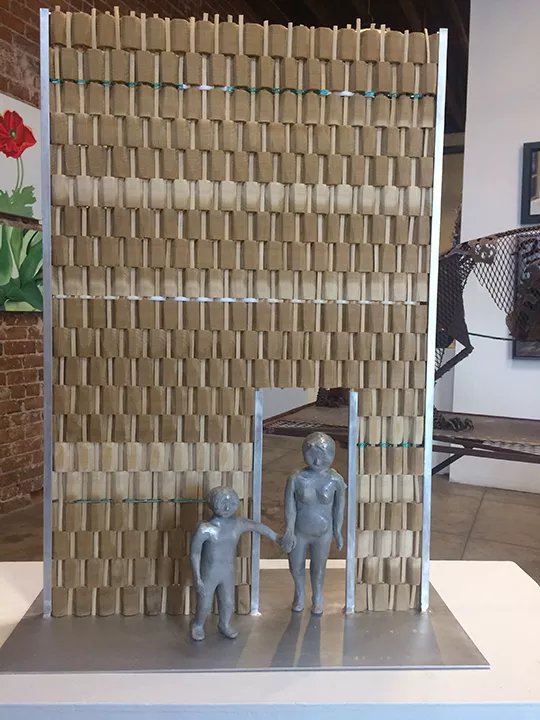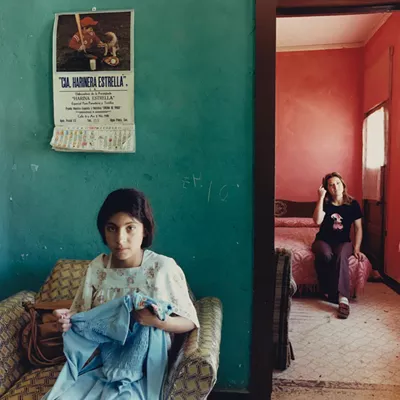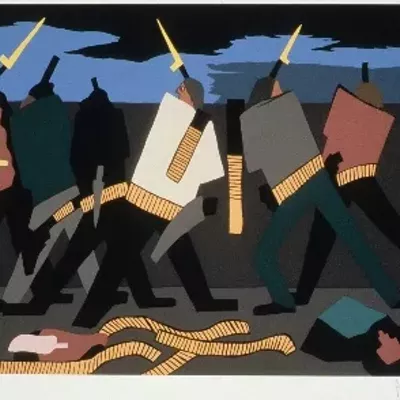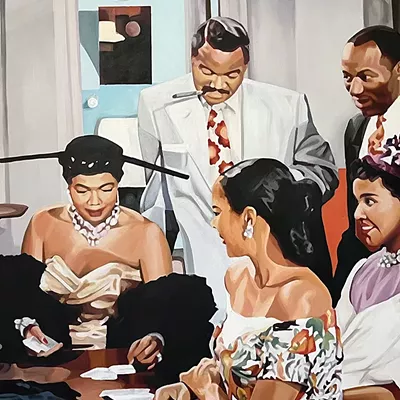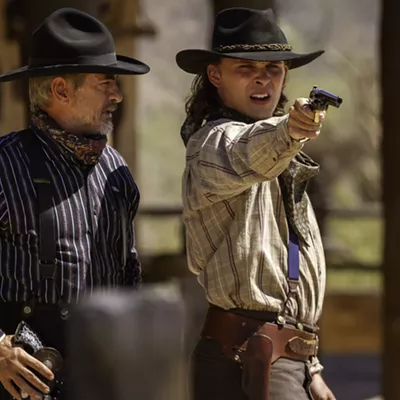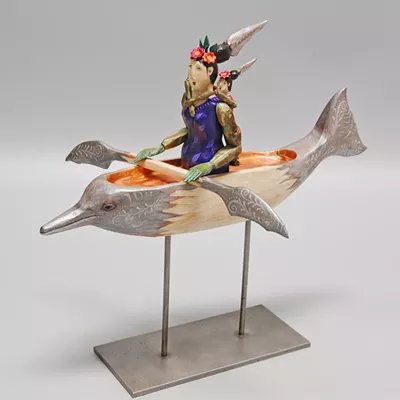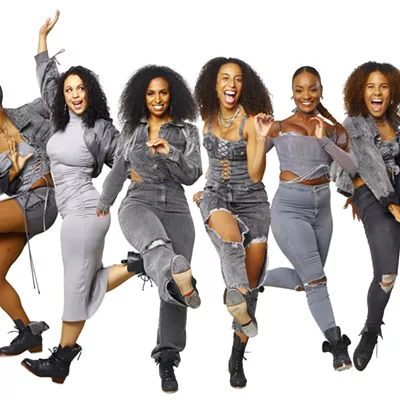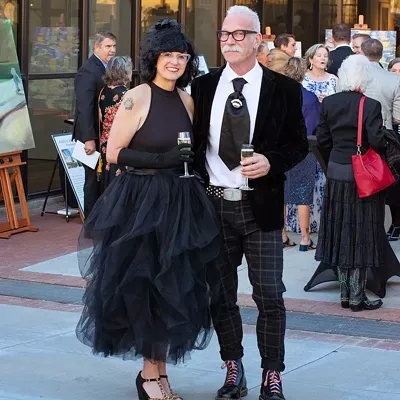In Agua Prieta, Sonora, on the south side of Uncle Sam's border wall, brilliantly colored murals have recently sprung up on the barrier's 20-foot vertical bars.
The huge paintings picture birds and suns and folkloric hearts; one features plain sky-blue paint that seems to make the wall disappear. And one standout mural is a painting of an open gate to the north, a clever optical illusion that suggests America still welcomes the earth's tired and poor and huddled masses yearning to breathe free, as Emma Lazarus's poem on the Statue of Liberty declares.
At Raices Taller's annual show of works by women, Mujeres, Mujeres, Mujeres, artist Perla Segovia had an idea similar to the gate muralist's. Her "Gateway of Courage" is a sculpture just three feet high, far shorter than the real walls scarring our southwest borders, but Segovia's wall also has an open gateway. Two small figures, a woman and a child cast in aluminum, have just walked through it to the promised land.
The woman's silvery metal hair hangs down her back in a braid, a style common to indigenous women of Mexico and Central America. Standing there at the end of her harrowing journey, she looks just like the ragtag women—and kids—who've been heading by caravan in recent weeks to the U.S., the "golden door" of Lazarus's poem.
Vilified for weeks by President Trump, news photos at last testified to the truth: the "invaders" of his imagination were mostly desperate women and children fleeing the chaos in Central America that the U.S. helped create.
Segovia's wrenching work is a highlight of Raice's annual show of works by women, which this year features 111 artworks by 68 painters. The exhibition is always an unapologetic blend of professional artists like Segovia and community artists, and this year even honors four promising students from Cholla High School.
Mujeres typically features a bracing mix of media, and artworks put together with an ingenious array of materials. The sculptural wall in the beautifully crafted "Gateway of Courage," for instance, is meticulously assembled of strips of woven wood, threaded in between aluminum and cotton and bits of kiln-fired glass.
Prescription medicine bottles and actual pills get the nod for most startling art material this year. Katherine Jendrzejewski put together a caustic collage of dozens of her own plastic pill containers in "Big Pharma." The vials, bristling out from a black board, add up to a denunciation of the powerful pharmaceutical companies.
The polar opposite of this political piece is a simple and lovely image of pink and yellow spring flowers in a vase by Adrienne Lehrer, a noted retired UA linguist. Instead of paint on canvas, Lehrer used dye on silk, and then stitched the piece together.
Stitched fiber works like Lehrer's pay homage to once-reviled traditionally female crafts. Ann Tracy deftly topples the old hierarchy that put painting at the top of the heap and women's fiber works at the bottom by embroidering her watercolor painting, "Confluence #2."
This wonderful work has an imaginative format: no fewer than 52 tiny watercolors fastened to the wall. Climbing in irregular patterns from the floor almost to the ceiling, the little abstracted paintings are in watery blues and greens, suggesting both sea and sky. Tracy has used embroidery in gray and black to add forceful lines to the loose paint; the lines hint at docks and bridges and seamen's ropes.
Former fiber artist Barbara Brandel uses not thread but postage stamps in "Queen of the Road," an entertaining rendition of a female motorcyclist. The work's media mix includes not only recycled stamps, but a map, acrylic paint, colored pencil, chalk pastel and paper.
Linda Bohlke's three complicated little works are drawings in archival ink and candy wrapper, put to rest in vintage tin candy boxes. "Unwrap Me" is placed on tin party horn, making it a sculpture; the other two hang on the wall. Their elusive black and white images range from a naked woman emerging from a forest to an almost-indecipherable wrinkly monster called "Arcturus Phrynosoma."
The show also has some fine examples of work in traditional genres. Karen Kyler's "Tombstone Canyon Cottonwoods," a classic etching moving from dark to light is a delicate drawing of bare-branched trees in winter. Tucson sculptor Barbara Jo McLaughlin made a floor work of five pieces of squared-off pine wood, each beautifully carved and incised. "Agave" by Hughette Nordin, an oil painting, is an abstracted vision of the beloved desert plant, its plump and pointy leaves shooting out across the canvas in every shade of green.
In this year of Me Too, the exhibition, surprisingly, may not be as overtly political as usual, but many works rejoice in women's growing power. Cristina Cardenas' "Jaguars," a litho in chine collé, is a portrait of a woman radiating the strength of a jaguar.
In "She Always Knows Better," Eva Kamenetskaya celebrates the female body at the same time that she lauds women's toughness. The black-and-white photo zeros in on a nude woman's torso; she confidently crosses her arms across her breasts, powerful and prepared for whatever life might throw her way.
But there's also rage.
Fabiola Bedoya evokes Ibsen's feminist play A Doll's House in her mixed-media accordion book "Welcome to the Doll House." The folding book's collage of images chart the dispiriting life of 19th-century women, from being treated as silly baby dolls to suffering the frequent deaths of real babies to being sexually assaulted. In one panel, a wolf dressed in man's clothing has grabbed a woman; she struggles uselessly to escape his grasp.
And "Gateway of Courage" has fury beneath its finely made surface. It rages against the dying of American compassion, roars for justice for refugees and howls against the hatred directed at women and children fleeing for their lives.

